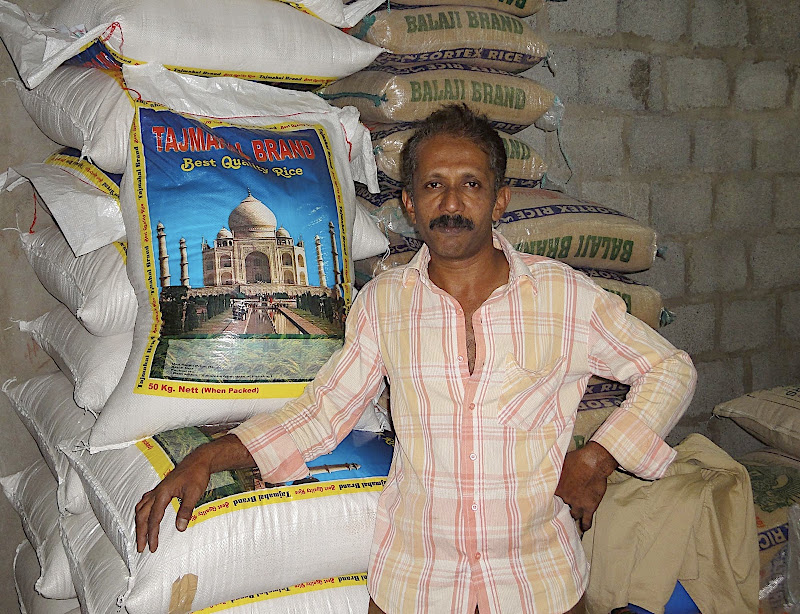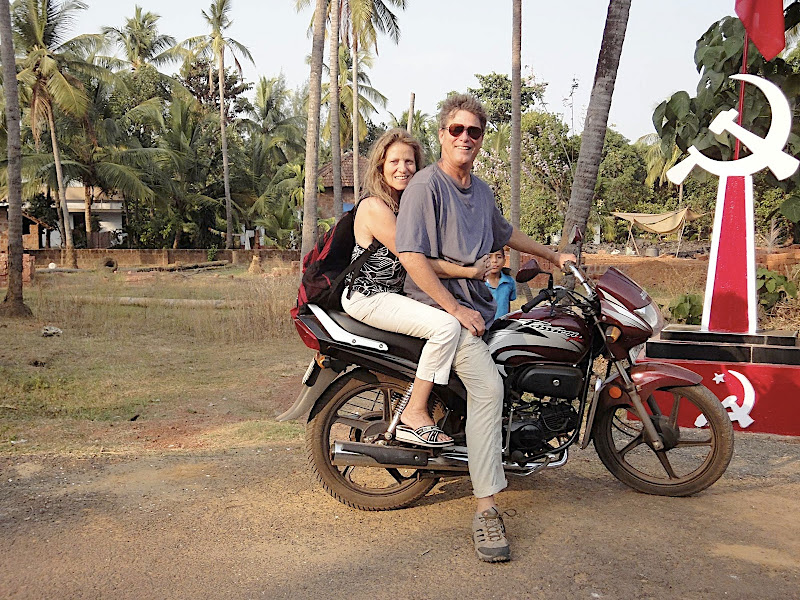Photos of India-2010
Each of the 7 photos below is linked to a photo album. You double click on the text below it and it takes you to that album.
If you are also interested in reading about our trip, it begins with Once Upon A Time in Southern India.
If you are also interested in reading about our trip, it begins with Once Upon A Time in Southern India.
#1 Album
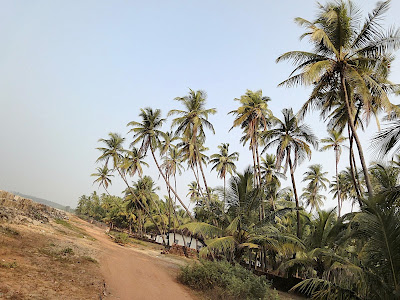 |
#3 Album |
 |
|
#4 Album |
 |
From India_Mumbai
|
From India_Hampi
#6 Album
|
 |
| From India_Goa
#7 Album
|
 |
| From Thailand_Bangkok+Chaing Mai |
The Movie
Once Upon A Time In Southern India
Intro
India! You either love it or hate it. If you are arriving from Planet USA, It comes at you like a steamroller, flattens you like Naan, then walks all over you with its suffocating pollution, noise, poverty, and population. Stuck in an endless sea of traffic (other taxis, buses, rickshaws, cows, and pedestrians) without a traffic signal in site, you come to terms with your surroundings.
India! You either love it or hate it. If you are arriving from Planet USA, It comes at you like a steamroller, flattens you like Naan, then walks all over you with its suffocating pollution, noise, poverty, and population. Stuck in an endless sea of traffic (other taxis, buses, rickshaws, cows, and pedestrians) without a traffic signal in site, you come to terms with your surroundings.
You are on a journey to your hotel, 3 km away that will take you over an hour. You are stuck. You can’t even turn around and go back to the airport. You know that your survival and enjoyment require a different mindset so you tweak your thinking, to give yourself over to the adventure. You soon become aware that you are breathing again and with each breath you let go of unrealistic expectations that you’ve brought with you.
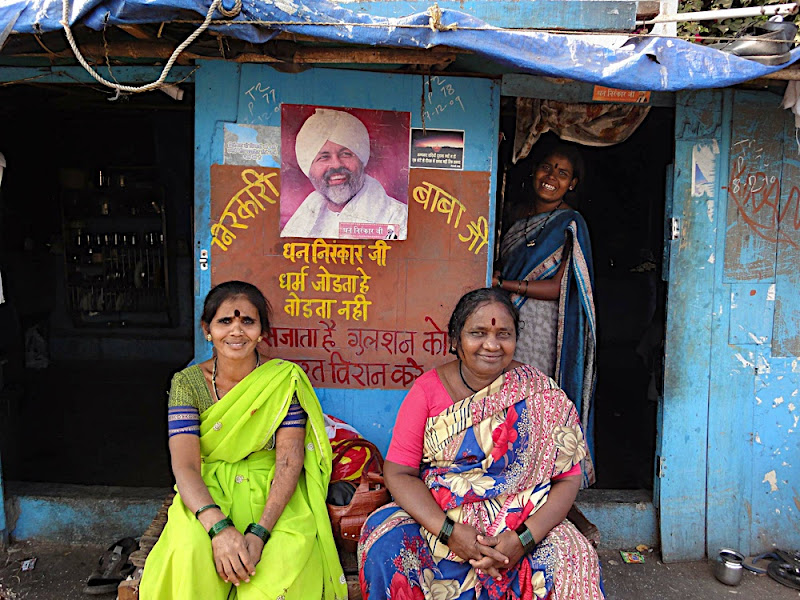 |
| From India_Mumbai |
You begin to notice colors in abundance, more rich and vibrant than daily fare back home. You become aware of families, Muslim and Hindi shopkeepers, and children playing in the streets with improvised toys. You observe interactions of loving kindness and commerce. You marvel at the exquisite architecture, while gasping for air as you pass over a stinky, polluted stream. You are slowly beginning to appreciate all that India is. You know that travel here won’t be easy, but that you are embarking on a memorable life, changing journey. You’ve turned a corner in your thinking, even before your taxi does. You sense the embrace of India, welcoming you. You are ready for anything.
This was a unique trip. Daily I would jot a word or two down using them as a springboard to share with you something that was memorable. I hope you enjoy the read.
Mumbai To The Tip
We left Mumbai early the next morning on a short flight to a small regional airport about 75 miles from Kannur. Mumbai to Kannur normally takes a slow-pokey, 22 hours by train, but we are meeting my daughter, Alex, so we opt to move quickly. On the way back to Mumbai we’ll travel the 1400 kilometers overland slowly, and get to know a little of Southern India. We’ve got 25 days and no agenda.
 |
Surprisingly air travel was inexpensive. It costs us about $85 to fly. We fly over the coastal hills and ocean just before we descend in awe at the beauty of the place. We hire a taxi. We cram our selves and luggage into it for the scenic coastal drive. This area is special. It’s expansive, green, and offers an island-like, tropical feeling. We are not relishing our return to Mumbai.
Kannur
Kannur is a city of approximately one million inhabitants. It lies along the coast, South West and to the left, of the tip of India in the state of Kerala. Not only does it have over a 90% literacy rate, but it also is India’s first democratically elected communist state. In Kannur, you see the hammer and sickle symbol everywhere. It’s a familiar symbol representing the communist party all over the world. Literacy and communism seem to me like ideas in opposition to each other. A few locals confided that the communist party, although corrupt, was so to a lesser degree than the opposition party. Like many developing countries bureaucracy, low pay, and inefficiency in government bring with it an unwritten expectation for money to motivate the system.
Where Am I?
As you wander the streets of Kannur, your senses are easily overloaded. Kannur has very narrow, often meandering streets. There are hardly any sidewalks. There are delivery trucks, cars, and buses to contend with, moving on roads were never designed for these larger vehicles.

Traffic everywhere in India seems chaotic not just in Kannur. There must be some genetic script labeled Navigation in India. I wasn’t born with it. Surprisingly we saw few accidents for all the mayhem. On my first experience riding a bike in city traffic, I was unable to make a right hand turn across traffic. I realized there was no way that I would acquire the necessary skill over the next few days, so I returned home and kept my riding to noncongested beach roads.
Gurukkal, the master, would have his young apprentice apply oil liberally in preparation for my massage by foot. He would also assist by placing me in different postures. Gurukkal, then hanging from ropes, would glide across my frame with his feet. He would control the intensity of the massage by how much of his own weight he would let hang freely. He increased his weight and thus the depth of the massage with each passing day. I was aware of a couple of chronically tight muscles that succumbed by the third treatment. I looked forward to my daily massage as a path to regain lost flexibility that I assumed was age-related.
The Kids
The children go to school daily and they do so in uniform. Many wore a light blue top with dark blue pants or skirts. It reminded me of my childhood and parochial school outfit. Everyone appears equal, no one richer than another, yet individuality finds ways to express itself. I observed the interaction and play of the children as always respectable and animated. Their eyes were sparkling and enthusiastic. I can still hear the younger kids calling to their parents, Ma Maaaaa! Pa Paaaaaaa!
The Girls
Women sit in different sections of the bus. If married, a man can sit with his wife, but only on the man’s side of the bus. Children can sit with either the mother or the father. There were always more men on the bus. Sometimes Sara would go sit with the women, while I was left standing, squeezed from all directions. Add the element of midday sun heating the bus to the boiling point made the ride a suffocating experience.
The Ice Cream Parlor And Fashion
They were wearing the black sack-like garment called a Burqa yet beneath it, their lives were richly colored. Normally no one notices their formless body shape nor is anyone aware of needs that they might have for self-expression. This, of course, is all conjecture. But it appeared to me that within they were enlivening themselves by their choice of vibrantly colored food. We also discovered that there exists an artistic world in the shadows of their dark garments. Read on.
In Kannur men are not accustomed to seeing exposed female flesh, even at the beaches. In fact Indian women enter the ocean fully clothed. Thus it's understandable why any scantily clad Western woman would draw a crowd of men. On a couple of occasions, we went to the beach to swim, even choosing more isolated spots hoping to avoid the inevitable. Men, dressed in conservative attire, not beach clothes, would wander into view from nowhere. Some would keep a distance to gawk, while others might venture near, faking a scenic photo with their cell phones. A couple of fellows, visibly excited tried to befriend me with questions, fully distracted by Sara and our foreign friends. The ladies aware of the unwanted interest, kept themselves submerged, only their heads visible above water, until the men disappeared as quickly as they had come. Out of respect for such cultural differences, Sara would wear a scarf draped over her shoulders and chest. On the beaches she would wear the Sari, a wrap made from one piece of continuous cloth that can cover the entire body.
Kannur Beaches Unabridged
The Fishing Village
I smiled and acknowledged them, as if they had just welcomed us. I then continued taking photos as if they were no longer there. They tire easily of this unexpected response and soon depart. Their backward glances revealed their confusion. The strategy worked and we took the opportunity to spirit away before they reevaluated our weak position and returned. Fear is a powerful emotion. It broadcasts one’s vulnerability, something easily sensed by others. The practice of invisibility and calm allowed us to move through, rather than confront, these dragons in our path.
Kalari Martial Arts
Kannur has a conservative, formal culture. When you are invited to someone’s home or an event, you are expected to show up promptly. We were invited to a weekly martial arts practice, as I was intrigued by its history. Kerala is the birthplace of all martial arts now practiced around the world.
This was no ordinary display of talent. These matches included the use of knives and other weapons. There was one action-packed performance with four on one that used real knives. Blades clinked loudly as students spun, jumped, and tumbled. It was truly impressive with young boys and girls performing at high levels of skill. These were future Bollywood idols.
Hot and Spicy
I found the Thali quite a healthy and filling meal. But even a non-spicy Thali was spicy and at times it was too hot for me to enjoy. Sara accustomed to the subtle Argentine diet, was challenged often to find dishes that allowed the flavor of the food to emerge without setting her mouth afire.
Holidays
Indians are used to crowding, given that there are so many people. Even in a cue you’ll feel someone pressed up against you even when there is obvious space at the end of the line. At first you suspect sexual interest, but in fact it’s a culturally distinct way of viewing personal space. Physical contact with strangers is more acceptable like in Argentina where hugging and cheek kisses are frequent. In America we tend to leave space between each other, especially in cues and crowded conditions like an elevator can become.
The Speak
There are extremes of wealth in India and the remnants of a caste system. It’s hard to believe that you are treated so differently by the chance of hereditary birth. In the caste system you cannot evolve or buy your way out of it. It is your place in a stratified Indian world. Though there are laws to protect against discrimination with over 70% of the population living in rural areas, the caste system is still prevalent. These social barriers continue to offend and restrict social movement. It reminded me of what freedom is all about, having a choice, being able to explore the smallest opportunity.
Whose Side Are You On
We were fortunate to be able to witness a Theyyam , a ritual dance performed in the temples of Kannur. It feels as old as it has been performed. For 1000 years actors have been fine-tuning the artistry of painting, costume, and performance. It was truly a unique experience and remains an important part of Kannur’s spiritual and cultural growth.
The trains in India are an important means for moving large quantities of people inexpensively. It’s a bit intimidating the first time that you go to buy a ticket, as there are so many people, trains, and passenger classes. We found it easy to do our research online, but we couldn’t book the ticket without paying ridiculous extra charges for using a foreign debt card. As foreigners it was better to stay in any car with first-class, air conditioning, and /or sleeper. The reasons being were security and comfort. These cars had an attendant, fewer passengers, and no access by the general public. The toilets were cleaner and thievery was less common. Vendors came through frequently at every station screaming Chai, yogurt, and hot dishes so you always had access to local, freshly prepared food. You could also order a meal from the diner car at very low prices.
Spitting
Money
I assumed that their bank would take the money, exchange it, and pull the questionable currency out of circulation. This is the procedure in other countries, but in India, they supposedly do it differently. I was told that the bank receives the money, then send it away for verification that the two halves are from the same bill and not counterfeit. Once it has been authenticated, a process that can take several months, the bank adds the money to your account.
Goa
In Goa there were miles of beautiful coastline, heavily developed as a tourist destination. No longer will you find sleepy little fishing villages that are mentioned in older guide books. You will only encounter the remnants of them with thousands of tourists tightly packed between the occasional boats like sardines. We never heard any warnings to avoid swimming here or there in Goa. Any reported drowning was most often due to excessive drinking.
The Goa Invasion Again
Arambol
Arambol Fishermen
Arambol High Tide
Arambol The Dark
Arambol Hygiene
Candolim
Animals
Goan Food and Flies
When you reflect on a trip, you recall beautiful beaches, exotic landscapes, and delicious fruit. You seldom recall the mosquitoes or sand fleas. Yet they can make a sunrise or sunset miserable. There is no joy in pondering a spectacular vista without a gentle breeze to control the critters.
Hampi to Hubli
Wok on Fire
Nearly Over
Where Am I?
As you wander the streets of Kannur, your senses are easily overloaded. Kannur has very narrow, often meandering streets. There are hardly any sidewalks. There are delivery trucks, cars, and buses to contend with, moving on roads were never designed for these larger vehicles.
Cars and motorized rickshaws continually honk their horns to warn of their arrival. Cows and humans are encouraged to use the side of the road. That doesn’t mean they do. There are few streetlights and street names. Addresses are often referred to by reference to some building, temple, or place, not by number or cross streets. It can get pretty confusing trying to navigate the streets by foot and not having any road signs makes it easier to get lost without a decent internal compass.

Traffic everywhere in India seems chaotic not just in Kannur. There must be some genetic script labeled Navigation in India. I wasn’t born with it. Surprisingly we saw few accidents for all the mayhem. On my first experience riding a bike in city traffic, I was unable to make a right hand turn across traffic. I realized there was no way that I would acquire the necessary skill over the next few days, so I returned home and kept my riding to noncongested beach roads.
Going For The Gold
In Kannur spices are the precious metal. Like gold, they have great value. Today they are harvested and exported around the world. For many years, the origin of spices being traded in Europe was a secret. Columbus set voyage to discover the source of these spices in a place called India. Instead he discovered America though initially he thought he had arrived in India. Thus America’s early inhabitants were referred to as Indians because they even looked like them.
Everywhere along the side of the roads, there is fermenting sewage. You catch frequent whiffs of odor that contrasts momentarily with the perfume of exotic spices. These ditches are home to every living insect in Kannur. If you want to study Entomology, you no longer need to go to Borneo. You can begin your research during Kannur’s raining season in these very caldrons of brewing bacteria. Your odds are good for notoriety and recognition, a gold-metallic wall plaque, naming your newly discovered species.
Walking down a street of many jewelry makers I noticed a brightly clothed woman lying by the side of the road with arm extended into the sewer. In her hand she had a gold pan and swirled it around with professional finesse. The water was putrid and fouling smelling. It didn’t stop her. Whether she got the idea from a movie or had some inside information, I’ll never know. I never did see any gold.
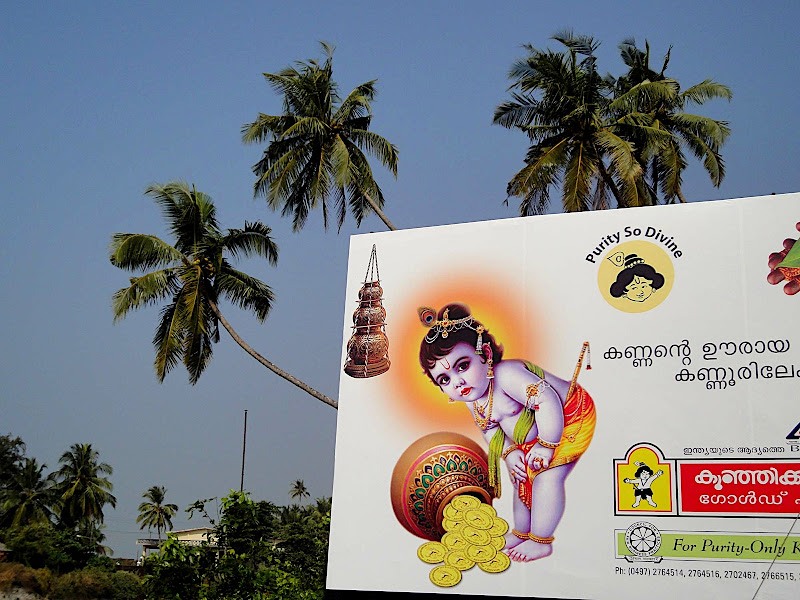
Kannur Massage

Kannur Massage
My daughter chose Kannur to continue her study of Ayurvedic practice, massage, and yoga. While she was busy during the day, we decided to undertake a massage treatment. I wanted a foot massage, not the kind that you're thinking. It was a Kerala foot massage where the masseuse hangs from ropes and uses his feet to give the massage. You prepare by dressing in a tiny, g-string made of cotton. That's the attire. You're hanging outeverywhere as one size fits all garments never perform as intended.
Two men gave the massage. The apprentice would apply warmed coconut oil, laced with different herbs selected to address your current physical condition. They might use different homeopathic formulations for different bodily issues. The amount of oil used was generous. Dry skin would soak up the oil like a sponge. You were then saturated again until hands and feet would slide easily over the body. I would suspect that a pint of oil was used on my first massage. I was to have 4 more days of treatment.
 |
Gurukkal, the master, would have his young apprentice apply oil liberally in preparation for my massage by foot. He would also assist by placing me in different postures. Gurukkal, then hanging from ropes, would glide across my frame with his feet. He would control the intensity of the massage by how much of his own weight he would let hang freely. He increased his weight and thus the depth of the massage with each passing day. I was aware of a couple of chronically tight muscles that succumbed by the third treatment. I looked forward to my daily massage as a path to regain lost flexibility that I assumed was age-related.
As I was doing a series of massage I was given a woven fibrous mat made from Coconut Palms for my use only, to lie on and absorb all the access oil. Every day they would perform the massage in an almost ritualistic fashion. I was asked to lie down, facing one direction, and then the other. My legs were crossed and uncrossed. I was placed on my sides, asked to sit, and my arms stretched high over my head. I was given a neck massage of rapid motion and intensity.
The massage always ended the same. I was given a heated mixture of secret essential oils and gestured to self-apply. Although scientifically immeasurable these lotions promised changes in performance and libido. Worth a visit to Kannur?
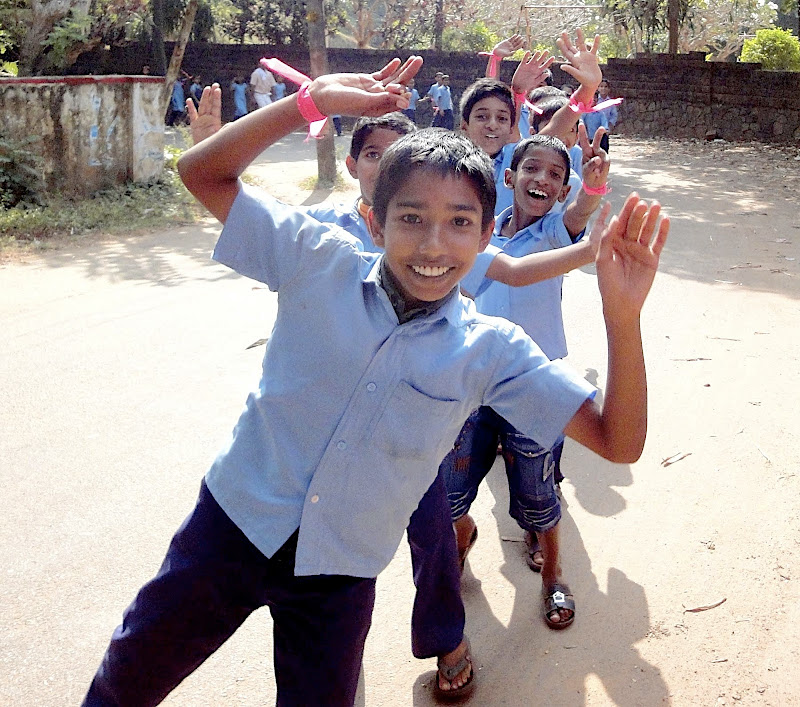 |
The Kids
India is very family-oriented and siblings visit the family of the others often. Because my daughter had made many friends over the last few years, they were all excited to meet Alex’s dad and included us in family activity from meals to visiting temples. This was the kind of travel experience that you dream of, but seldom are presented with the opportunity.
The children go to school daily and they do so in uniform. Many wore a light blue top with dark blue pants or skirts. It reminded me of my childhood and parochial school outfit. Everyone appears equal, no one richer than another, yet individuality finds ways to express itself. I observed the interaction and play of the children as always respectable and animated. Their eyes were sparkling and enthusiastic. I can still hear the younger kids calling to their parents, Ma Maaaaa! Pa Paaaaaaa!
The Girls
There were never very many women on the streets of Kannur. We discovered that Muslim women were at home and not allowed to freely roam the streets. I heard stories that women once married, were never let out of the house unless escorted by their husbands. The culture seemed repressive in that way.
Divorce in India carries a stigma with it, especially for women. Though it is possible to get a divorce, it is frequently seen as a non-option. Each religion has its own set of grounds for divorce. But most telling is the fact that there are only 5 reasons for a divorce in India versus 16 reasons in the majority of Western countries. The 5 reasons are adultery by either spouse, desertion of at least 3 years, cruelty (metal abuse, physical, and/or neglect), impotency, and chronic disease.
 |
| From India_Kannur |
Women sit in different sections of the bus. If married, a man can sit with his wife, but only on the man’s side of the bus. Children can sit with either the mother or the father. There were always more men on the bus. Sometimes Sara would go sit with the women, while I was left standing, squeezed from all directions. Add the element of midday sun heating the bus to the boiling point made the ride a suffocating experience.
The Ice Cream Parlor And Fashion
I laughed quietly. I am in search of air conditioning and ice cream. It’s just too hot today. It wasn’t always that way for me. I used to think that a little suffering and inconvenience added to a real appreciation of people and place. In fact a few years ago I didn’t mind sharing a bathroom down the hall, but now it is one of life’s pleasures that I’m less reluctant to forgo. I get lucky and find my oasis.
In the coolness of the ice cream parlor I have an unexpected revelation into Indian Culture. There were two Muslim women, in full black attire, eating Sundaes of multicolored fruit. The visual contrast was memorable. Wrongly I believed their lives to be colorless and drab. But the truth revealed itself as you watched how they consumed these desserts called Tootie Fruities. Perhaps each was feeding her soul with the name, the flavors, and the colors. That yummy treat appeared to satisfy a longing. As if the pleasurable act of consumption offered some potent release. That it would make a difference on how they accepted their world as defined by Allah and interpreted by men; how they embraced life moving anonymously through their day.
 |
They were wearing the black sack-like garment called a Burqa yet beneath it, their lives were richly colored. Normally no one notices their formless body shape nor is anyone aware of needs that they might have for self-expression. This, of course, is all conjecture. But it appeared to me that within they were enlivening themselves by their choice of vibrantly colored food. We also discovered that there exists an artistic world in the shadows of their dark garments. Read on.
Sara was invited into a Muslim home, where she discovered, like women all over the world, that they were very interested in the latest fashion. They wanted to know where Sara bought her sandals, her jewelry, or her unusual scarf. In an almost childlike manner, they offered to dress Sara up in the latest Muslim fashion. Proudly, excitedly they opened their closet, showing their wedding gown and jewelry collection. Under the cover of the black burqa and only for the husband or other women to see, their personal fashion choices were revealed.
The Burqa worn by the Muslim women is in stark contrast to the Hindu women who wear colorful, vibrant fabric. The Hindu woman dressed as if having consulted a fashion designer. They always look freshly put together, even on the hottest of days. Wrapped in colorful cloth, the red dot on the forehead added a punctuation mark to their individualized statement of dress. It also tells all-male admirers that they are married.
The Guys
You frequently see men sitting together in small groups, often drinking Chai, a delicious, spicy Indian tea. Sometimes they are playing card games or chess. While walking, they will hold hands or have arms draped about each other. They are comfortable with such visible displays of affection whereas in the US one avoids such public displays of friendship as it might be misinterrupted.
In Kannur men are not accustomed to seeing exposed female flesh, even at the beaches. In fact Indian women enter the ocean fully clothed. Thus it's understandable why any scantily clad Western woman would draw a crowd of men. On a couple of occasions, we went to the beach to swim, even choosing more isolated spots hoping to avoid the inevitable. Men, dressed in conservative attire, not beach clothes, would wander into view from nowhere. Some would keep a distance to gawk, while others might venture near, faking a scenic photo with their cell phones. A couple of fellows, visibly excited tried to befriend me with questions, fully distracted by Sara and our foreign friends. The ladies aware of the unwanted interest, kept themselves submerged, only their heads visible above water, until the men disappeared as quickly as they had come. Out of respect for such cultural differences, Sara would wear a scarf draped over her shoulders and chest. On the beaches she would wear the Sari, a wrap made from one piece of continuous cloth that can cover the entire body.
Kannur Beaches Unabridged
Kannur Beaches are beautiful with slow-moving waves that curl up on fine, grainy sand. It’s a pristine paradise, sort of. What you don’t notice, until you near the water’s edge is the quantity of human feces that riddles the low tide line.
You will want to arrive at the beach after 8am, if you intend to avoid this daily bathroom and bathing ritual. Yes, the fishermen are discreet. You begin to fully appreciate the versatile design of the simple white sheet piece of cloth called the Dhoti with which the Indian men clothe themselves. It can be used floor length or wrapped like a skirt above the knees, thus easily modified for squatting, swimming, socializing, and cooling the body.
We would be meandering an expansive, isolated stretch of beach when out of nowhere, someone would appear, go to the sea, squat and pee, then disappear again. It didn’t happen often, but more than once so you remember it.
 |
| From India_Kannur |
This custom was not apparent on every beach. It was more noticeable a few kilometers out of town. There you’d find intermittent zones covered with caca, as if planted with land mines. I suspect that this has been a habit of tradition for centuries.
In Nicaragua I once visited a small isolated village where they built an outhouse, facing the ocean, on stilts. The sun would bake the feces and eventually it was burned. In Nepal they make paddies of cow poop, stick it to the side of their homes, and burn it to make bread after it dries. As far as I know, this Indian problem is not managed, but tolerated. For hygienic reasons alone more attention needs to be given to resolving this issue.
I noticed this practice to a lesser extent on the developed beaches of Goa. I never saw women squatting on the beach. I never noted a reference to this problem in any guidebook. I’ve never seen this habit practiced on the beaches of other countries.
The Fishing Village
On one of our beach excursions we decided to explore a new area. The day was beautiful and the beach pristine. The sea lay to our left side, a deep blue, while to the right the shoreline was delineated with palm trees. Ahead of us was a village situated below some cliffs and an impassable outcropping of rocks that interrupted the shoreline.
In some cultures bones and other objects are hung from wooden poles, acting as gates at the village entrance. They warn of danger and psychologically ward off unwanted intruders and evil spirits. In the approach to this village we were surprised at the amount of feces littering the beach. There were hundreds of piles, from fresh to sun-baked, distracting us like broken glass, from the incredible beauty and serenity of the place itself. The village was quickly loosing its curb appeal.
We continued cautiously as two young men in their early twenties approached us. They physically blocked our progress and with an in your face tone, confronted us with questions. “Who are we? Where are we from? Where we are going?” It was an unnerving moment and distinctly different in feel from other encounters we’ve had. I become acutely aware of our isolation.
 |
| From India_Kannur |
Kalari Martial Arts
Kannur has a conservative, formal culture. When you are invited to someone’s home or an event, you are expected to show up promptly. We were invited to a weekly martial arts practice, as I was intrigued by its history. Kerala is the birthplace of all martial arts now practiced around the world.
We arrived at the center, located in a temple grounds, about 15 minutes late. Gurukkal, my masseuse, is also a Kalari martial arts master and was visibly worried. He thought that we were not coming. Indian people are very thoughtful and gracious. He had arranged for us an hour of student demonstrations as performed in competition.
 |
| From India_Alex in Kannur_2010 |
This was no ordinary display of talent. These matches included the use of knives and other weapons. There was one action-packed performance with four on one that used real knives. Blades clinked loudly as students spun, jumped, and tumbled. It was truly impressive with young boys and girls performing at high levels of skill. These were future Bollywood idols.
Gurukkal himself did a fight with sticks against an agile young lady. There was also another match where he used an ordinary towel to subdue knife attacks originating from 2 different directions.
When the demonstrations concluded, the students greeted their waiting parents with formality and respectfulness. Life had returned to a tranquil, reserved state from this highly energized, momentary display of disciplined play.
Hot and Spicy
I was surprised to find that vegetarian options were common restaurant offerings. A very typical lunch or dinner that I enjoyed was called a Thali. It’s a Keralan dish consisting of a heap of rice in the center of an oversized platter surrounded by small cups of different toppings, such as curried spices, coconut, spicy and pickled chopped veggies, eggplant, and yogurt. You spoon a topping onto the pile of rice. Then using your right hand, you eat.
The meal is served often with Chai or a glass of pre-boiled water. You are also usually offered freshly baked flatbread, like naan or chapattis, whose blander taste balanced nicely with potent spicy flavors. Flatbread also became a useful means of scooping your meal.
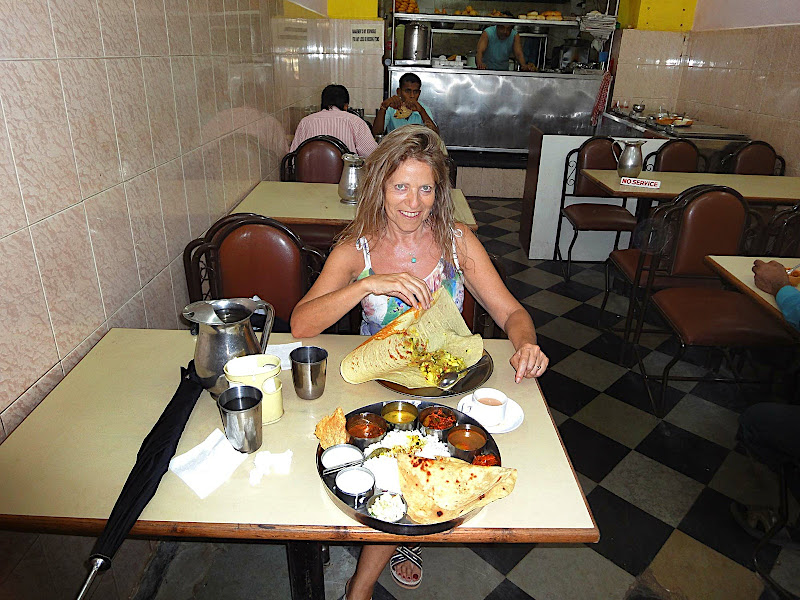 |
| From Sara and Kent India/Thailand_2010 |
I found the Thali quite a healthy and filling meal. But even a non-spicy Thali was spicy and at times it was too hot for me to enjoy. Sara accustomed to the subtle Argentine diet, was challenged often to find dishes that allowed the flavor of the food to emerge without setting her mouth afire.
Thirst
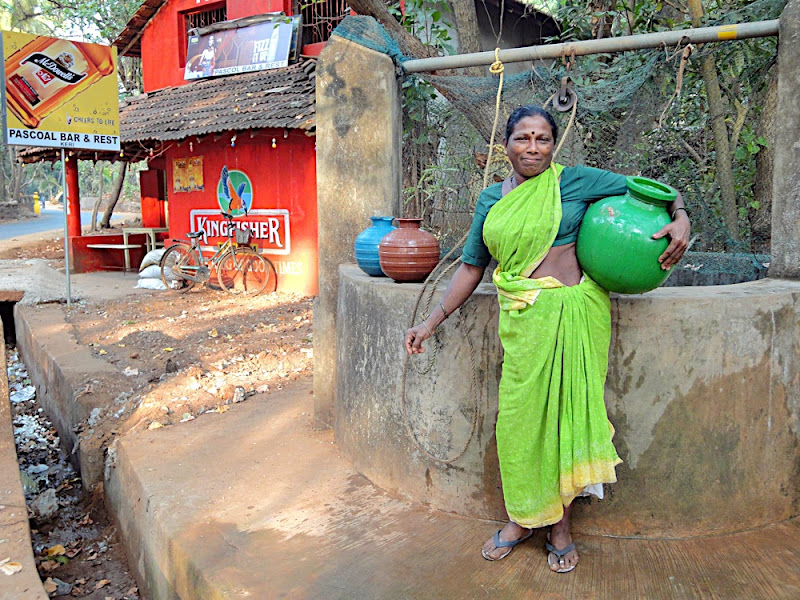 |
| From India_Goa |
Water contamination is a real problem in India. It often comes from a well and you sometimes see villagers filling containers to balance on their heads and take home. In towns where there is a water system, like Mumbai, even though it may be treated, you don’t drink the water without boiling it. Our hotel had its own purification system. Thus a hot tea or cup of hot water is the normal beverage served with lunch unless you order bottled drinking water or pop. The problem with bottled water is that the bottles end up everywhere and are not recycled in an appropriate way. You have to be careful as creative entrepreneurs will fill used plastic bottles with unfiltered water and sell it. That is why it is a good idea to always order bottled water unopened, even in restaurants.
Holidays
Chinese New Year and Valentines Day were both celebrated while we were in India. This was the Year of the Tiger. We learned that there are only 1411 tigers left in India. The fact is startling and there is an effective awareness campaign to save the remaining few from extinction. Valentines Day was celebrated much like it is elsewhere. Most interesting is noting the universal appeal of the holiday, and that we really aren’t so different.
So Many
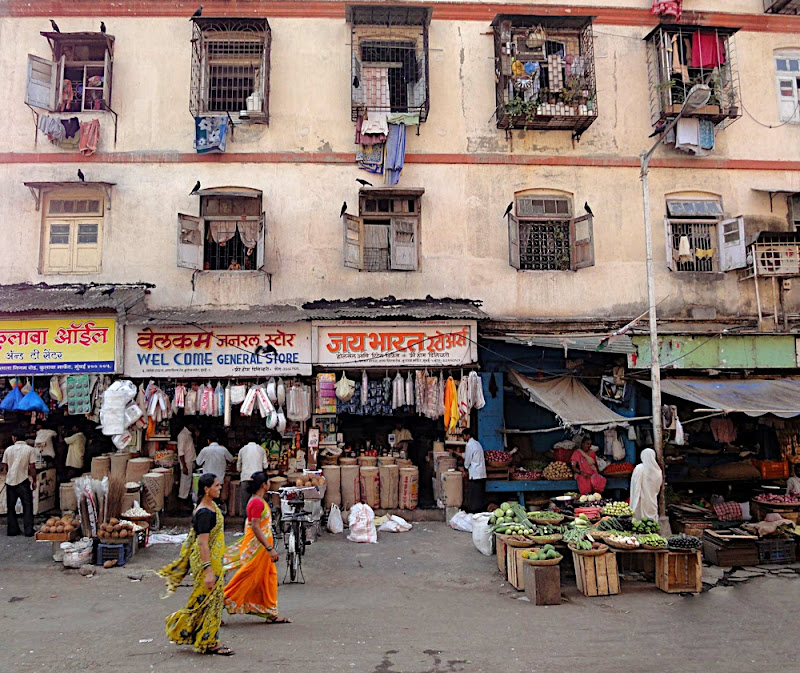 |
| From India_Mumbai |
Indians are used to crowding, given that there are so many people. Even in a cue you’ll feel someone pressed up against you even when there is obvious space at the end of the line. At first you suspect sexual interest, but in fact it’s a culturally distinct way of viewing personal space. Physical contact with strangers is more acceptable like in Argentina where hugging and cheek kisses are frequent. In America we tend to leave space between each other, especially in cues and crowded conditions like an elevator can become.
The Speak
There are so many languages in India that people cannot communicate from state to state. Though one would expect Hindi to be the common language, it is English that dominates. Thus for us, Language, unlike past adventures in China, was a non-issue, while traveling in India.
Extremes
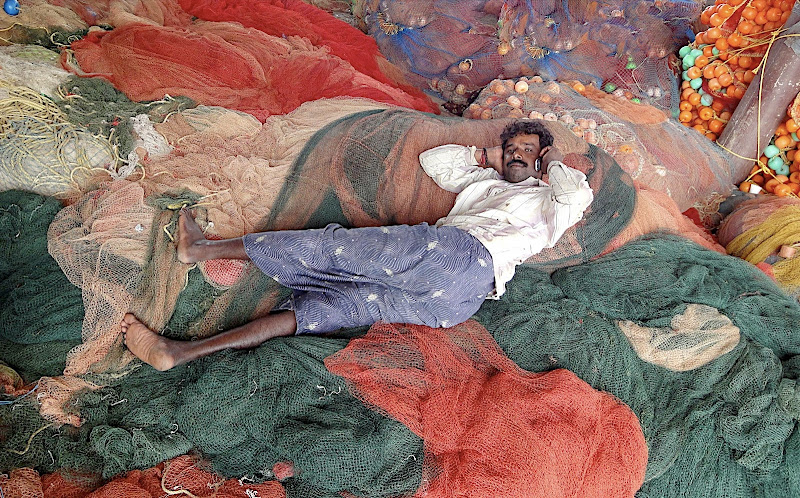 |
| From India_Kannur |
There are extremes of wealth in India and the remnants of a caste system. It’s hard to believe that you are treated so differently by the chance of hereditary birth. In the caste system you cannot evolve or buy your way out of it. It is your place in a stratified Indian world. Though there are laws to protect against discrimination with over 70% of the population living in rural areas, the caste system is still prevalent. These social barriers continue to offend and restrict social movement. It reminded me of what freedom is all about, having a choice, being able to explore the smallest opportunity.
Whose Side Are You On
In India you drive on the left. Apparently that’s the only rule of the road. It doesn’t mean you have to stay there. Cars weave easily back and forth from lane to lane. If you’re a bigger vehicle, such as a bus, truck, or SUV, there is some unwritten entitlement rule that grants you more time in the right lane of oncoming traffic as well as the status to pass all others vehicles at high speeds. Speeding is acceptable. Things can get complicated, as most of the traffic is comprised of cows, motorbikes, pedestrians, and rickshaws. Somehow the greater majority survive or at least you don’t notice any decrease in population. Really I didn’t see a lot of accidents, but I wouldn’t want to negotiate the main roads there.
No Tango, A Theyyam
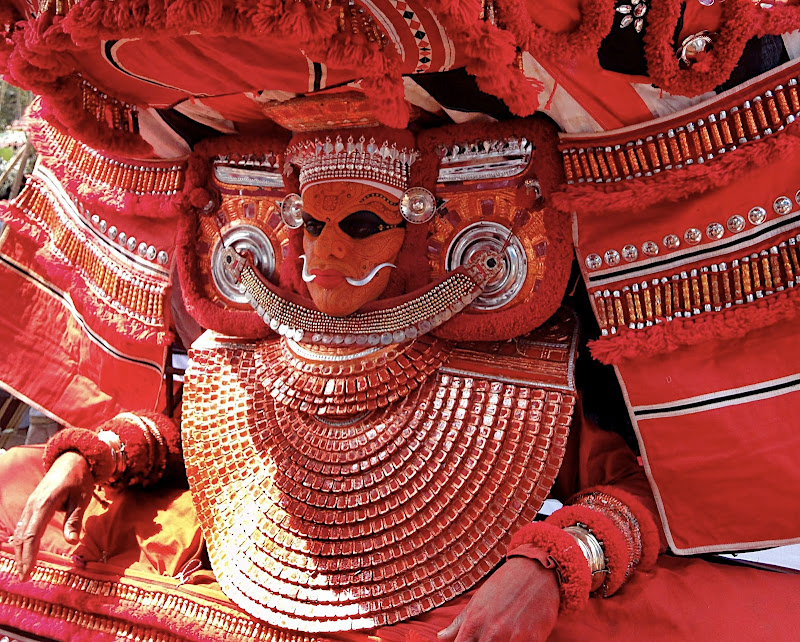 |
| From India_Kannur |
We were fortunate to be able to witness a Theyyam , a ritual dance performed in the temples of Kannur. It feels as old as it has been performed. For 1000 years actors have been fine-tuning the artistry of painting, costume, and performance. It was truly a unique experience and remains an important part of Kannur’s spiritual and cultural growth.
The artist is painted and dressed elaborately in a practice that can take a couple of hours of preparation. He is groomed in the tradition of the dance and must observe to it in every detail of his performance and dress. He becomes a momentary deity. He elicited a passionate response from devotees as he circled the temple grounds to beating drums. He wore heavy headgear that projected 25 ft in the heavens. He danced back and forth, blessed devotees, and spun faster and faster to the beating drums. Drummer and performer each inspired the other.
What we missed was an opportunity to see a Kathakali ritual dance drama. It is supposedly one of 8 Indian classical dance forms. The actors, male and female, perform in extravagant costume with facial painting like the dancer at a Theham. I love to dance. Dance of all kinds. For me, this would be reason enough to return to India.
Trains
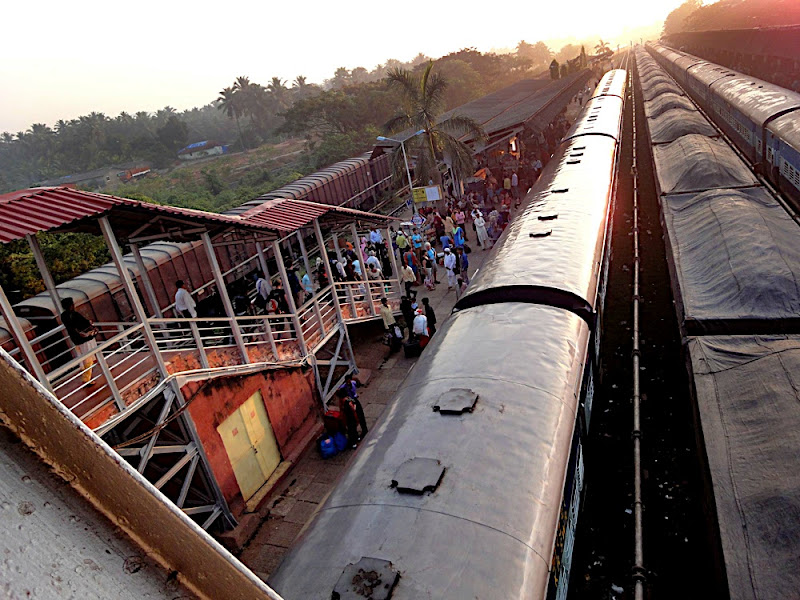 |
| From India_Hampi |
The trains in India are an important means for moving large quantities of people inexpensively. It’s a bit intimidating the first time that you go to buy a ticket, as there are so many people, trains, and passenger classes. We found it easy to do our research online, but we couldn’t book the ticket without paying ridiculous extra charges for using a foreign debt card. As foreigners it was better to stay in any car with first-class, air conditioning, and /or sleeper. The reasons being were security and comfort. These cars had an attendant, fewer passengers, and no access by the general public. The toilets were cleaner and thievery was less common. Vendors came through frequently at every station screaming Chai, yogurt, and hot dishes so you always had access to local, freshly prepared food. You could also order a meal from the diner car at very low prices.
These cars were not what you might expect for a category of first class. Yes, they were more expensive, but the ticket was still a bargain. India offers some of the cheapest train tickets in the world. It cost US$50 for an overnight, first-class sleeper on a 10-hour journey to Goa. A third class fare cost US$15. In the later case, you would be sitting on boards, no cushions, and sharing the car with four times the people. In an upscale car, though it might visually appear third class to our standards, it had a curtain for privacy with 2 single bunks. Another option included 4 bunks in a shared space. Clean white sheets were provided and they contrasted dramatically with the drab, run-down appearance of the car’s interior. It is easy for one’s enthusiasm to get muddied by expectation of the train’s condition. I found solace comparing the experience to wilderness camping and appreciated the luxury of having my food prepared. The hole in the floor that served as a toilet was an open pipe. Passengers used it as well to dump trash on the tracks that screamed below.
On a trip from Kannur to Goa we were unable to find information as to what station to disembark for Arambol. When we crossed into Goa, a helpful local suggested a small station called Thivim. The train didn’t always stop there but this one did and from there, it was a short taxi ride to Arambol.
 |
| From Sara and Kent India/Thailand_2010 |
This was a 50-minute train ride beyond our ticketed destination. It turned out to be easy to make the ticket change without leaving the train, but the charge added 30% to our overall ticket price. Ticket price is calculated by distance traveled with longer journeys costing less per mile. Passengers that had booked our seats from Madgo onward were told by the conductor to find temporary seating elsewhere. I found that odd as I was willing to give up the seat and stand, knowing that the train was heavily booked.
A little known fact is that if you are unable to book a ticket because the train is full, you can return no earlier than 24 hours before your train departs when a few more seats are released. You pay an additional $5 charge for this privilege. You are competing with people from all over India for these few seats, so it behooved us to arrive at the ticket counter an hour ahead of its opening. My online research showed that out of 5 trains a week passing through Hampi, there were no seats available for over a month, so it was a few extra dollars well spent. Ask for a Taktal booking.
Toilets
It takes some getting used to but balancing on oversized footprints and squatting over a hole in the floor is a common bathroom scenario in India. Sometimes you encounter a Western-style toilet with seat, but only in the more extravagant hotels. They are not so common. Toilet paper also is still a luxury and hand sprayers are strategically located. There are no Bidets.
Bathroom etiquette dictates what hand is used to eat or scoop your food. Silverware is less common. The right hand is used for eating while the left is used for bathroom chores. Thus you never want to pick up your food with your left hand.
Spitting
I don’t think I’ll ever get used to the spitting. They spit everywhere including the streets, bathrooms, walls, and floor, even inside the train’s first-class air-con sleeper cars. It’s disgusting. It’s also a major cause of the spread of tuberculosis.
It’s an educational issue, like safe sex and condoms or handwashing practices and the function of soap. China had a similar problem until it banned spitting and gave fines and jail time to offenders. A spit free China lets you appreciate the wonderful culture and architecture that make China such a special place.
Money
Money in poor condition is normally difficult to spend in any country, so the experience has taught me to refuse questionable change. This time I was caught unaware. I received a bill of 100 Indian Rupees that was in very new condition but had been torn in half, then carefully taped. It wasn’t missing a piece or scribbled on. In fact I didn’t notice the tape when I received the change and really doubt I would have refused it. However, no one would accept the bill and I was told to take it to the bank. This could involve waiting in long lines so I suggested to several shopkeepers that when they deposited their daily funds it would cause them no inconvenience and could they please accept the note.
 |
| From India_Mumbai |
I assumed that their bank would take the money, exchange it, and pull the questionable currency out of circulation. This is the procedure in other countries, but in India, they supposedly do it differently. I was told that the bank receives the money, then send it away for verification that the two halves are from the same bill and not counterfeit. Once it has been authenticated, a process that can take several months, the bank adds the money to your account.
It is interesting to note all the emotion that such an experience generates. No one likes to be taken advantage of. You get angry at first, remembering the vendor who gave it to you, and how it was purposely hidden in your change. Then you start to think how clever he was and how many months he might have been waiting for our paths to cross.
This is India where one journeys to explore Hindu Philosophy of which Karma is an essential component. You search your memory for any incident that justifies your receiving a worthless note. What does it mean? Did I do something similar in my past to someone else? In the end you become determined not to be a victim. You buy a cup of Chai on a train, barely moving, from a vendor who scrutinizes the note, then hands you a wad of old, worn money that you normally wouldn’t accept. Where is that taped note now? I don’t know but its got more value than its current owner realizes. Someone took notice. It’s got its own travel story. It has got to be worth more than 100 Rupees.
Goa
The Arabian sea touches not only the coast of Kerala but also the shores of Goa and the city of Mumbai. In Kannur we experienced several days where the sea was as calm as glass, even though we had read that swimming in these waters was dangerous due to rip tides. Like any ocean, you need to respect it and local knowledge helped us decide on where it was safe to swim and where it was not.
 |
| From India_Goa |
In Goa there were miles of beautiful coastline, heavily developed as a tourist destination. No longer will you find sleepy little fishing villages that are mentioned in older guide books. You will only encounter the remnants of them with thousands of tourists tightly packed between the occasional boats like sardines. We never heard any warnings to avoid swimming here or there in Goa. Any reported drowning was most often due to excessive drinking.
The Goa Invasion Again
First the Portuguese invaded Goa, then came the French, the English, and now the Russians. Indian people are not happy about these nouveau riche tourists. They find the Russians rude and crass. They come with lots of money and expectations. They bring prostitutes and drink heavily. They are demanding and treat locals in a subservient way. They fit the description of the personified “Ugly American” but this tidal wave comes from Russia without Love. They arrive in chartered flights and take over sections of the beach. For them and many Europeans, Goa offers the warmth of the sun, beautiful beaches, and a cheap out of country experience. Back home it is freezing cold with life deep in snow.
Arambol
Our first Goa beach was Arambol. It was full of young yogis, aging hippies, and low budget travelers. Here everything was cheap, so travelers stayed for several weeks or longer. It was very different from the beaches further south that were over-developed with lots of upscale lodging. It is also where you’ll find European group charters and the main Russian contingent.
In Arambol you could rent a bungalow on the beach with a sand floor. I’ve done that on the beaches of the Yucatan where you’d be continually bombarded by insects. There were no fans to lessen the oppressive heat. The huts were always dirty as you can’t really sweep a floor of sand. It’s a fond memory, camping for pennies, in the most gorgeous of surrounds with easy access to the ocean and only 5 minutes from the Mayan ruins of Tulum, but comfortable it was not.
 |
| From India_Goa |
We leave our luggage at a guesthouse making it easier to walk and find a decent room. We got lucky and found a place on a rocky outcropping, only 10 feet above the high water line. It had a great room. The air was cooler and had movement by the sea. The onshore nightly breeze couldn’t pass the palm trees and cool the village as it did us at the water’s edge. At night you could hear the water lapping on the rocks. The room had a queen-sized bed, ceiling fan, private bath, and patio to sit and enjoy beach activity and star lite nights. It was double the cost of other lodging options but at $20US a night, we weren’t complaining and able to enjoy a bit of yesterday’s paradise today.
Arambol Fishermen
The beach itself was very picturesque. The fishermen would haul their wooden boats in and out of the water. It usually took a group of maybe fifteen and a couple of logs on which to slide the boat up onto the sand. On the water many of the boats had sails that were used to take them offshore and bring them back again. They didn’t allow for much maneuvering.
In the morning the fishermen would sell their catches on the beach. They would unload the fish into waiting buckets. You could choose the size and quantity without ever dipping a net.
 |
| From India_Goa |
Some fishermen dragged nets in the shallows, harvesting schools of sardine-sized fish, only a few feet from shore. There was always lots of excitement and teamwork required to keep the fish from jumping over the nets and escaping back to the sea. Once on the beach the small fish would be frantically flapping, gasping, and inching their way back to the water. The men would drop to their knees and scoop up handfuls of them, tossing them away from the water’s edge. Not only was this a tourist zone, but a functioning fishing village with daily activity to support their trade.
Arambol High Tide
One evening we decided to have a coffee on the beach. They literally carried a few tables and chairs to the sand. It was a warm evening with a slight onshore breeze. The stars were visible by the millions and the sound of waves breaking made for a special evening. As we sat, I noticed the sea seemed to be rising more than previous evenings. The moon came out and it was perfectly round. We were experiencing a full moon tide. We of course had to abandon our table and chairs to the sea. All was uneventful though the water later rose halfway up the rocks to our room where it normally would hardly touch the bottom stones.
The beach of Arambol seemed cleaner than others. I discovered one morning on a walk at daybreak that the beach was being raked. There were plastic water bottles everywhere. There was an assortment of dead fish and cow droppings. It wasn’t that there was less unsightly pollution, only that it was being managed. Within a few hours the beach would be full of topless sunbathers and yoga practitioners.
Shopping Arambol
 |
| From Sara and Kent India/Thailand_2010 |
In Arambol there was one narrow, single lane that wound off the highway several kilometers to the beach. It was lined with vendors selling everything imaginable, one tent after another, like at a temporary mall. It was basically a pedestrian route also used by mopeds and motorcycles that would race the gauntlet of shoppers. They drove dangerously, as if oblivious to the potential risk they presented to the maze of walkers.
Arambol The Dark
There is a dark side to the place. There is no police presence in Arambol. There are a lot of drugs, drinking, unsanitary conditions, and excessive speeding here. These things may be an attraction, but there are safety concerns worth noting. Until you are a victim of a drug or alcohol-related crime, sickened by bacteria in your food, or reckless road maneuvers, it’s easy to dwell on and promote the carefree nature of Arambol.
Unfortunately the town has become known as the rape Capitol of India. Most of the incidents involve drunken tourists not using common sense. But it made all the papers recently, when the story unfolded about a 9 year who was molested by 2 Indian men at the beach in daytime hours. One accomplice distracted the mom while the other took the child into the water, unnoticed by the mother. They caught the guys, 2 businessmen from the Delhi area, but it points toward the skimpy clothes, bare breasts, and drug usage that clash with conservative Indian culture. I’m trying not to make a judgment here, but only note that when one tries to live by their own cultural norms in a foreign country, those norms and practices may collide with the culture you are exploring. You can expect pain.
Arambol Hygiene
The only time that I got sick in India was at a restaurant in Arambol. I required an antibiotic treatment for drinking a Lassi that had fermented during one of the frequent power outages. A Lassi is a delicious yogurt-based drink often mixed with fruit. I questioned the restaurant manager who assured me that it was okay. He used a straw and appeared to sample my drink. As a Lassi can have a sweet, tart flavor, I foolishly accepted his proclamation, even though Sara was convinced it was bad. As usual I should have listened to Sara. I ended up with a severe case of dysentery.
The next night 2 young Israeli’s ate at the same restaurant and both got sicker than I, barfing loudly, death moans of agony, the entire night in an adjacent room. In the morning I gave them some electrolyte solution and the name of the antibiotic that worked for me. There was no health control body to report too. Unfortunately there was no motivation for the restaurant to clean the kitchen and monitor hygiene.
Easy Riders
I rented a motorcycle in Arambol. We stuck to the secondary roads and beach accesses where we avoided the majority of coastal traffic. Sara had never ridden one except in Kannur and was still a tad nervous. I could feel tension through her grip around my waist and imagined her eyes tightly closed. When her grip relaxed, she began chatting about Che’s trip around South America, Easy Rider, the open road, and how essential bikes were in rural areas where there was infrequent public transport.
 |
| From India_Hampi |
Instead of a family station wagon, you would often see a family of 3 or 4 on a bike designed for one passenger. You would also see drivers shuttling incredible loads, precariously dispersed over the bike’s frame. It could be the Peddler selling Pots and Pans or workers carrying large sticks of timber. These were their mini-vans. As useful as the bikes were, they were still dangerous. In Goa 2008 there were reported over 4000 bike-related accidents, 300 deaths, and 350 injuries. No helmets, speed, and alcohol were the culprits.
Motorbikes need gas and stations are few and far between. Small stores are prepared to fill the competitive vacuum and your tank by selling recycled liquor bottles filled with a liter of petrol. The problem is that gas has gotten expensive. If you can keep the price down, then you will sell more gas. In order to do this the petrol is cut with 40% Kerosene. The bikes still run, profit margins are good, but the mix does havoc on the engine. Let the Buyer Beware!
Goa No Further
In Goa the motorbike freed us to explore the back roads. We got lucky. We discovered a beach that had beautiful white sand and few people. It was the Goa I was looking for. The one they talked about in the early seventies. We returned several times to frolic in the blue sea, eat fresh barbequed fish, and bask in the quiet of lazy, sun filled days.
The beach was located at the very end of the state of Goa. You literally could "Goa no further!" It was the best beach of all and it was the last beach, ending where a riven flowed into the sea. In a couple of years it would be full of like-minded travelers, seeking the same experience, but it's unlikely the experience will be available to them. At the moment the specialness of the place is burned in my memory. I prefer to remember it this way. Once discovered it will become like the rest of Goa, a destination for European and Russian Charters.
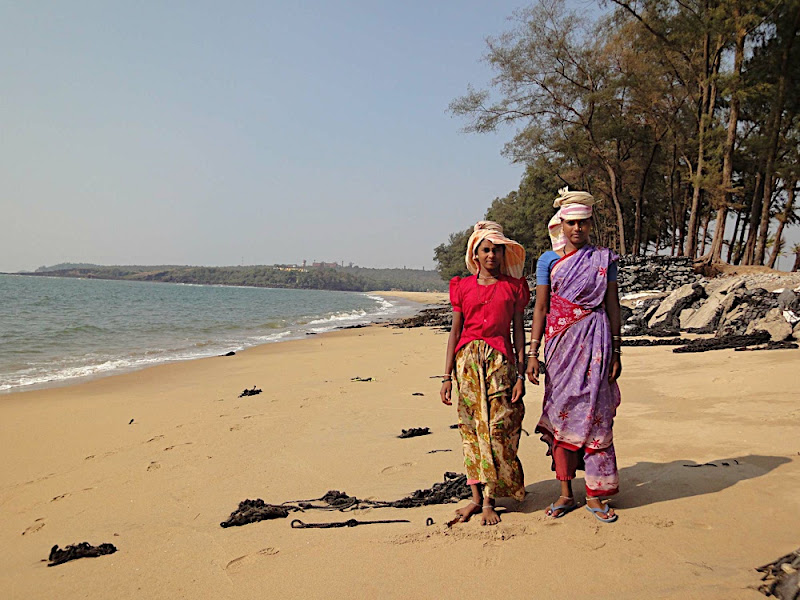 |
| From India_Goa |
It Couldn't Happen To Me
I was so careful with the bike and never expected the unexpected circumstance that felled it. We were on a road of hardened sand. A taxi had preceded me and I very slowly, 5 mph, moved cautiously along the road. At one point the road split and I crossed the center of the road. It looked packed hard too, but it was like quicksand, and grabbed the tires pulling them down several inches. It was enough to cause me to lose the balance of the bike and as if in slow motion, we fell over. I’m so thankful that we were only moving at a snail’s pace. I got burned touching the tailpipe and my finger got crushed under the handlebars. Bikes are dangerous. We were lucky that our lesson learned was not more serious.
Candolim
There were many beach resorts in the state of Goa, one every few kilometers. This was pretty much the case for its entire 97 kilometers of coastline. You can imagine that many of the communities were very similar with only a few that stood out. Candolim was one of those resorts. It was well located with interesting places nearby, like the Aguada Fort, the town of Panaji, ritzy Calangute, and Baga Beach.
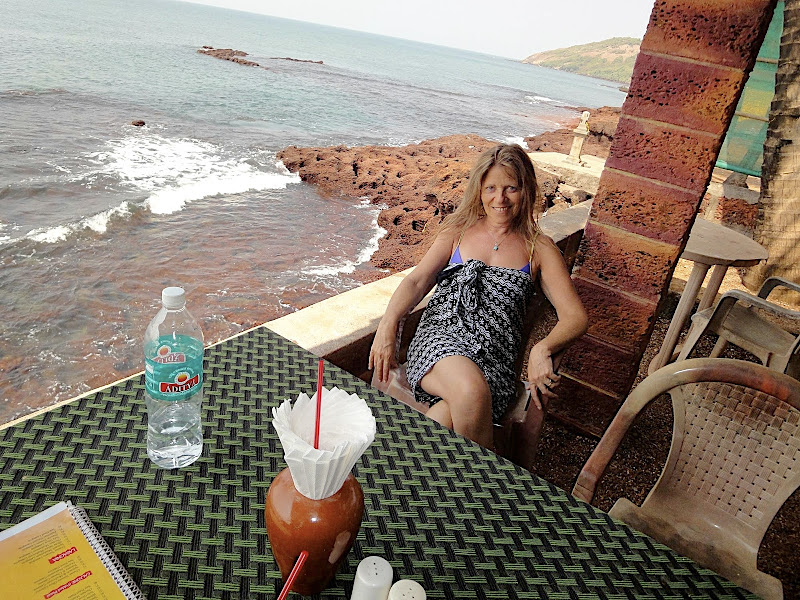 |
| From Sara and Kent India/Thailand_2010 |
In Candolim we encountered even more money, more topless women, and longer stretches of desirable beach. The beaches here were generally more crowded. In the distance of a 3 hours walk, we observed an uninterrupted curtain of sunbathers. It reminded me of Mar Del Plata, Argentina in the summertime.
Tourists were served by one beach shack after another offering the same food and beverage choices. Here they could hang out all day on lounge chairs with multicolored umbrellas that gave momentary reprieve from the sun. They would spend their tropical days drinking beer, basting themselves with oil, eating, reading, and doing little else. Exercise and sightseeing was not why they were in Goa.
 |
| From India_Goa |
Candolim Vendors
 |
| From India_Goa |
Vendors patrolled the beach. They offered every imaginable gift to you, for your friends, and for your family back home. They were mostly young girls who would plop themselves down next to you and have you try on bracelet after bracelet or model beach hats and T-shirts. They were charming and relentless. There were also vendors from Rajasthan peddling fresh fruit in baskets balanced on their heads. They walked the sand at the shoreline, wearing bright, mixed patterns of colorful ethnic dress. You couldn’t help but be enchanted by the striking contrast of colors against the sea and white sand.
 |
| From India_Hamp |
Most shops were on the noisy main coastal road. The traffic was continuous with both small and large cars, trucks, and buses competing for the lead. Young people, riding scooters and cycles, would also weave in and out at excessive speeds. It was like an obstacle course for them, but very dangerous and uncontrolled.
This road was also the only way to get to the shops and other beach towns. Built years ago it was now inadequate to meet today’s bigger vehicles. Pedestrians could only walk along the side on the dirt where vehicles would often go off payment for passing. It was surprising that we witnessed few accidents. I later learned that there were many.
Animals
Several times on the beaches we encountered a pack of dogs. They appeared homeless and only once did a handful of them threaten us with big teeth and bad breath. I was glad that I recently had a rabies shot.
The sacred cow seemed to be everywhere as well. I’ve seen them trying to enter restaurants begging for food. They sometimes would stop traffic for several minutes until urged off the road. On the beaches they could roam freely. You’d invariably find a few sun bathing with the tourists.
Goan Food and Flies
One of the attractions of Goan beach communities was the western food choices available. You could have pancakes, bacon and eggs, home-cooked breads, and salads rather than Muslim fare. After a few weeks of a spicy diet with not much variety, you longed for something reminiscent of the familiar. Some travelers understood this need and have used it as an opportunity to support themselves. They have started mini businesses and settled into Goan Life.
Though I might relish a change in diet from time to time, the flies don’t seem to show a preference. They would eat anything and everywhere. It became a ritual to place a small pile of crumbs away from my plate so the flies would give me some uninterrupted time to enjoy my meal.
Body Language
Every culture has its body language. We are accustomed to answering “yes” by shaking our heads up and down. The Greeks use the same head movement to say no. In India people express yes, no, hello, goodbye and probably a lot more thoughts with a bobbing head. They have the ability to sway the head gracefully back and forth and then back to a point of balance on the neck. Your eyes meet another and the head bobs. You ask for confirmation of a direction and the head bobs. It is a nonverbal gesture and not so easily done correctly.
In the milongas of Buenos Aires where low light levels can make it difficult to confirm the cabeceo (a tradition of asking for a dance through eye contact), Sara and I sometimes will improvise with the Indian head bob. It clearly reads….Hey, Babe, wanna’ tango?
Everyone Has A Job
 |
| From India_Mumbai |
When we arrived at the Mumbai airport, the driver found us by holding a card up with my name on it. Two men that appeared to be with the hotel taxi service confidently took our luggage from us, and walked with us and the driver. When we got to the parking lot the driver asked us to wait while he got the car, but said nothing about the guys helping us with the luggage. Soon they started demanding money for rolling our luggage to the curb. It then occurred to me what was going on. They were not thieves. Everyone has a job or creates one for themselves. This was right out of Survival India, chapter one. We were experiencing lessons learned well in one of the most populated countries in the world.
 |
| From India_Mumbai |
I recall walking into a small Pharmacy where there were 7 attendants in identical uniforms chatting behind the counter. It was late morning with lots of sidewalk traffic, but Sara and I were the only customers. Yes, there is an abundance of people willing to work for very little, but more importantly, with work there is dignity and the side benefit of less crime.
The Thrill of The Kill
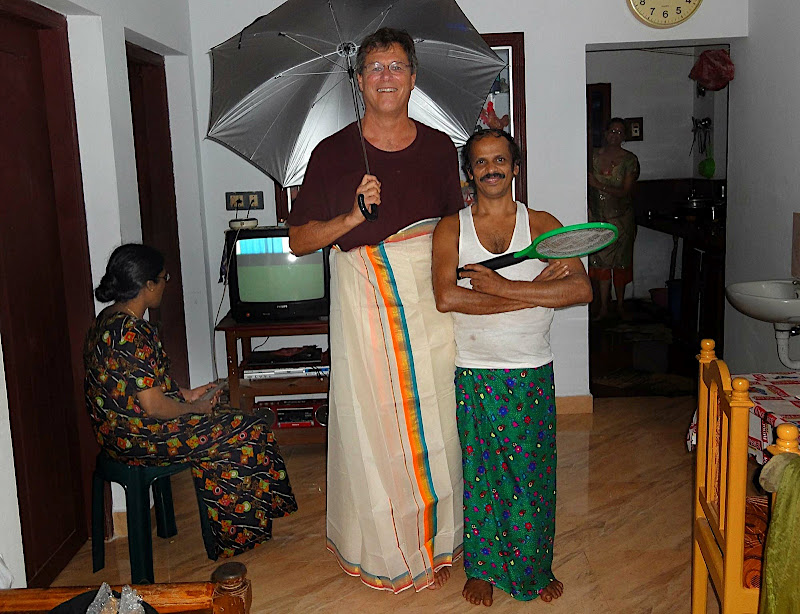 |
| From India_Alex in Kannur_2010 |
Back at your hotel, you close the windows which make it hot and uncomfortable for you, but not for them. How much more unwelcoming can you be. Somehow they find invisible openings. They are persistent and long for the taste of blood. You cannot hide from these vampires even under the sheets.
The ones that find you, that bite you, could be carrying malaria or Dengue fever. These are not pleasant thoughts. It;s easy to see how a beautiful day can end in a sleepless night.
You hear them. You know they are circling. You swat at them with newspaper until the walls are bloody from battle. This is a reoccurring nightmare for anyone even those with diplomatic privilege all over the tropical world. Only a shower, a fan, or a repellent offer a momentary reprieve. That is, until now.
In India I discovered a joystick of lethal retaliation. It’s not a spray. It looks like an electrified tennis racket. You can improve both your swing and your hunting skill serving deadly blows to the mosquito world. It even eliminates no see-ums, fleas, and other insects that hop about the bedroom. The stench of fried mosquito can be horrific, but I’ll admit pleasure in the hunt. It’s green and chemical-free.
It’s easy to return to primal roots. It’s all about survival in a hostile world. Sara praises me for a good fight and that all is safe in the world though is anguished when stepped on. She bids me to holster my weapon, turn off the lights, and come back to bed.
The fan whirls and I drift back to sleep. I hear one hovering, but it’s only a dream. I remain calm, unbitten, in my insect-free paradise. Perhaps it’s a similar dream that we share with friends and not the true experience.
Mosquitoes of Buenos Aires should listen closely. I brought home one of these secret weapons and I’ve charged it up. Before you bite, be prepared for a fight. I get such a chill, not to mention the thrill, from a bloodless kill.
Hampi
 |
| From India_Hampi |
Hampi is a world heritage site in the middle of Southern India. It was worth the extra effort to get there. You felt as if you stepped back in time, into a living museum, as the town of Hampi itself is situated in the middle of ancient ruins.
The place is a national treasure full of old temples set amongst a surreal landscape of oversized boulders. The temples are intricately detailed with many still used today for worship. At the main temple I stood in line with others. When my turn came I gave some coins so that I could be blessed. I was blessed with a somber kiss on my head. It took the power of an elephant’s nose to release my bliss. It was nothing more than a simple kiss. You come to India for moments like this. Amen.
Hampi to Hubli
We decided to fly back from Hubli Airport. Hobli was half the distance back to Goa from where our trip had originated. Trains were booked for over 2 months in advance and buses, though readily available, were taking 24 hours for the return. Unfortunately with the train station located 40 minutes away, we couldn’t easily investigate any last minute availability. When told that the trip time to Hobli was 3 hours by car, we jumped at this option. We planned to depart in the early am and arrive at the airport shortly before our flight to Mumbai. This was to become an unexpected, unnerving adventure.
 |
| From India_Hampi |
The story really started even before we left Hampi. There are lots of hands in every transaction. The son of our hostel owner was said to be a booking agent, so we accepted his mother’s word. Once we met him, He kept changing the price with every passing hour. It was apparent from his twitching eye that he was lying, every excuse turned into a request for more money. He knew that with our plane tickets confirmed, we had little choice but to pay up. It was too late to find other transport.
We found out later that for the price of a local call, he would pocket 50% of the fare. The driver and owner of the car were furious when he realized the size of the agent’s commission, normally 15%. He was a local and he felt hustled. We of course were hustled all over India. There always seemed to be a middleman. Everyone got a few coins for anything you could label as a service. It was the uncharacteristic greed of this guy with his twitching eye that gave him notice, leading to my disdain.
We had planned to leave at 4 am, but because of a washed out bridge, we would now leave at midnight. This was hard to fathom. The twitching eye worsened with further explanation. This was making me very uncomfortable. It was extremely dry in Hampi and not a rain cloud in the sky. More importantly we now would not be traveling during daylight hours. This was a lot riskier and something that I normally would never agree to. There was always a chance of an unexpected animal, person, or vehicle to suddenly appear on the road and cause an accident. Such a scenario was common in remote areas.
We took a brief snooze, were woken at midnight, and prepared to depart Hampi. We needed to meet and pay the balance of our deposit to the driver. I wasn’t happy about full payment in advance given the risk should his car break down and we miss our flight, but what now had me concerned was the mystery passenger. We had specifically asked, as we were paying for the car, that we did not want any other people in it. The extra space would be added comfort and the destination was not just a short ride.
Because of the hour and this latest development, the potential for robbery had me at a heightened level of concern. No one would miss us for a couple of weeks. Tourists were being warned to stay away from isolated areas after dark and to be observant as people were being robbed after eating food laced with drugs.
 |
| From India_Hampi |
We were leaving the safety of Hampi after midnight and I wanted some control over the situation. You are most vulnerable when you are in transit, as you normally carry everything with you. I felt that one person, the driver, I might be able to manage, but not 2 people. To make matters worse the passenger looked like a Gorilla on hormones. We told him Sara was ill and we planned for her to lie in the back seat of the car. I would ride in front with the driver. There was no room for him. There was some rapid, loud chatter in the local language that included a few unnerving glances and chuckles. Finally it was agreed that the Gorilla would remain behind so we paid the balance. In adventure travel there has to be a healthy balance between risk and common sense. We were very close to not leaving the lights of Hampi.
There was a major pit mine nearby. Thousands upon thousands of oversized trucks traveled round the clock delivering ore to the Goan coast. From Goa the ore was loaded onto barges and transferred to waiting vessels bound for China. I counted over 25 large ships off the coast near Condolim.
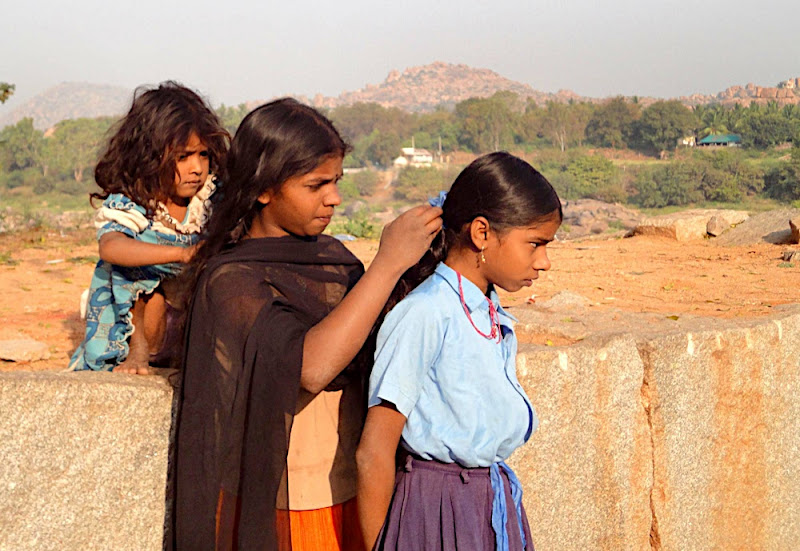 |
| From India_Hampi |
The road itself was two lanes wide. Trucks were coming and going in both directions, so they often had to drive with one set of wheels riding the dirt alongside the road. This made for dusty conditions and added to the poor visibility. There were no streetlights and the wipers only seemed to shift the dust enough to see the road.
The trucks moved slowly bumper to bumper like freight cars on an overloaded train. Our driver would dart in and out at every opportunity to pass trucks, sometimes 5 to 10 at a time. On one section the road was dirt and potholes for several miles and you would feel every bump and brake. The oncoming lights were also blinding. It wasn’t unusual to find ourselves on the dirt to the right of the oncoming trucks. These were the trucks returning empty from Goa. They moved faster with no load. It was a very tense situation sitting in the suicide seat my head at the height of the truck bed and oncoming lights. Any sudden braking by a truck ahead of us could take out our windshield and anything behind it. A couple of times I ducked and wondered if the driver understood why I was sitting so close.
There were delays, broken down trucks, but surprisingly few accidents. There was no washed-out bridge that required an 80km detour. Looking back at the convoy of trucks as we left them to enter Hobli seemed surreal. They were so large and so many. I was exhausted and breathed a sigh of relief, quickly wanting to put that experience behind me. The trip had taken twice as long as expected.
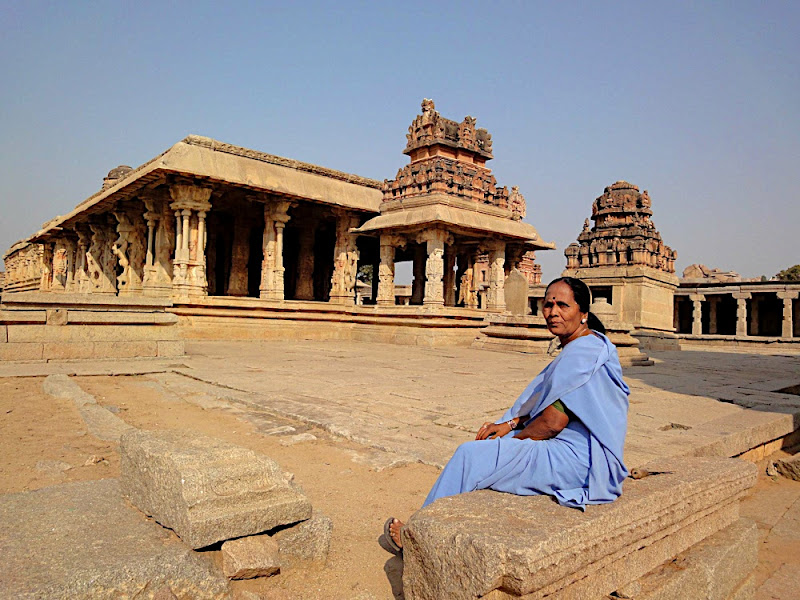 |
| From India_Hampi |
Hubli
We arrived at the airport at 430am. It was on the outskirts of town surrounded by fields. The terminal was closed with not one light on or any person in sight. The entry gates were chained shut and we began to wonder if the place was abandon.
Moments later a plainclothes policeman with passenger pulled up to investigate. The rider had a very old style military rifle sporting an unusually long barrel strapped to his back. It gave them the appearance of bandits. We were told that the airport wouldn’t open until about 8am and it was too dangerous for us to wait outside the gate. We decided to find a budget hotel. The policeman became our guide and directed our taxi to a couple of hotels where we finally secured a room. A hot shower and brief 3 hr. sleep washed away the dust and relaxed any tension leftover from our all-night ride. In the morning we had a Muslim breakfast and flagged down a rickshaw to take us to the airport.
Mumbai Revisited
On our return to Mumbai we stay at the Sea Green Hotel on Marine Drive. It’s an old building with history. It was probably quite nice when new, but now it’s just a well-located, expensive hotel by the sea. Still having its own elevator operator and attentive floor staff sharply dressed in white beckoned to other times. I enjoyed sitting on the balcony, reading Mumbai’s English Newspaper, pondering the boats, the drifting clouds, and watching locals exercise on the Rambla. In only another hour of morning light, the heat and humidity would become oppressive.
Again Mumbai traffic was bumper to bumper with everyone honking horns at the same time. Most of the traffic consisted of thousands of black and yellow taxis. You want to use the meter and avoid negotiating a more expensive tourist fare. The buses were packed like a sardine can with people hanging out the doors and windows to escape the suffocating air. There is no way I’d take an overloaded city bus as public transport is used by over 85% of the Mumbai population. I know. What happened to my adventuresome spirit!
 |
| From India_Mumbai |
Wok on Fire
After India, Thailand was easy to navigate. We headed to the hills of Northern Thailand where there was cool air and forests nearby. I’ve been to Thailand many times and my favorite northern city is Chaing Mai. In years past I’ve taken a couple of cooking classes. The first session left me with dysentery and on antibiotic treatment. Not a fond memory. The next time the experience was more rewarding and I became more competent at chopping veggies. But by far, my third class, taken on this trip, was the best. I learned that most Thai cooking uses the same spices and ingredients but in different proportions. This opens up a whole range of creative Thai cuisine. I learned how to tell a ripe pineapple by how easily its stem can be removed. I learned the difference between Jasmine rice and sticky rice.
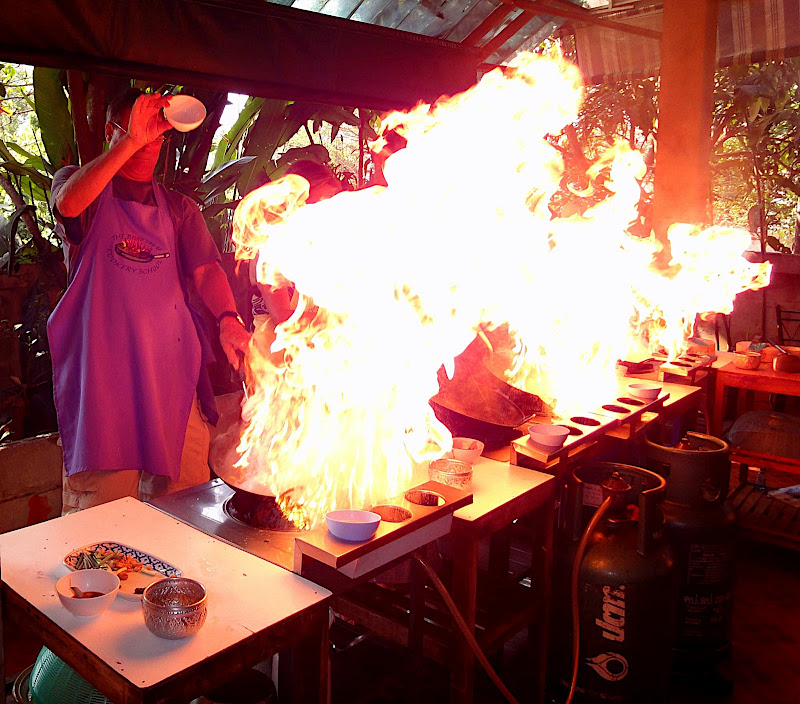 |
| From Sara and Kent India/Thailand_2010 |
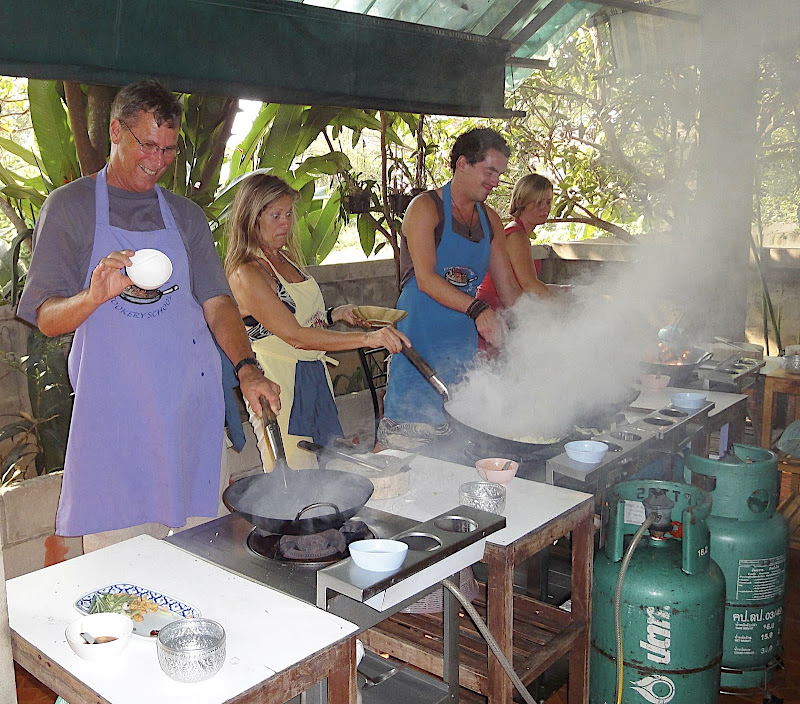 |
| From Sara and Kent India/Thailand_2010 |
I also learned how to add drama to my Thai cooking with fire. Carefully mix water and veggies into hot peanut oil. My first attempt was unexpected and spectacular with flames shooting out of the wok 3 feet in the air. I need to work on my technique but at least I learned how to avoid singing my hair.
Nearly Over
India. Will I go back? It’s a resounding yes! There is the possibility of journeying to mountainous villages that reach the borders of Nepal and Bhutan. There is the Tibetan community where the Dalai Lama lives in exile from his homeland of Tibet. There is the Rajasthan culture, Jaipur, a possible camel safari, many breathtaking forts and temples. There is the Taj Mahal, Old Delhi, the lake region of Shrinigar. All is noted on my bucket list.
 |
| From Sara and Kent India/Thailand_2010 |
Senor Kent
Buenos Aires, Argentina
May 2010



